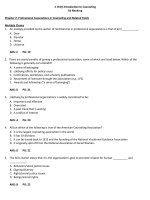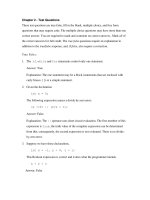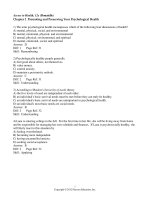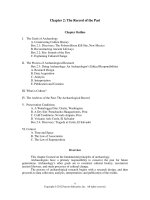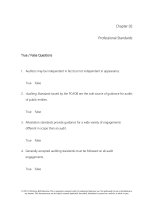Genetics from genes to genomes 5th edition hartwell test bank
Bạn đang xem bản rút gọn của tài liệu. Xem và tải ngay bản đầy đủ của tài liệu tại đây (436.82 KB, 37 trang )
Chapter 02 - Mendel’s Principles of Heredity
Chapter 02
Mendel’s Principles of Heredity
Multiple Choice Questions
1.
What was the importance of Mendel performing reciprocal crosses?
A.
To be able to breed plants all year round
B.
To obtain enough plants to perform the experiments that Mendel wanted, which would not have been sufficient without
performing reciprocal crosses
C.
To disprove a hypothesis at the time the experiments were performed that stated the ovum carried all the information for
progeny
D.
To demonstrate that the inheritance of a trait was not dependent on which parent carried the trait
Bloom's: 2. Understand
Learning Objective: 02.01.03 Explain the importance of Mendel's inclusion of reciprocal crosses within his controlled breeding program of
pea plants.
Section: 2.01
Topic: Background - The Historical Puzzle of Inheritance
2-1
Copyright © 2015 McGraw-Hill Education. All rights reserved. No reproduction or distribution without the prior written consent of
McGraw-Hill Education.
Chapter 02 - Mendel’s Principles of Heredity
2. What is the difference between cross and self fertilization?
A. In cross-fertilization the gametes from one plant are used to fertilize the gametes of another
plant
B. In cross-fertilization the gametes from one plant are used to fertilize the gametes from the
same plant
C. In self-fertilization the gametes from one plant are used to fertilize the gametes from
another plant
D. In cross-fertilization insects are used to pollinate the plants while in self-fertilization the
investigator pollinates the plants
Bloom's: 2. Understand
Learning Objective: 02.01.02 Describe how Mendel cross-fertilized and self-fertilized pea plants.
Section: 2.01
Topic: Background - The Historical Puzzle of Inheritance
3. What is the outcome of breeding two plants each pure bred and each having an antagonistic
trait?
A. Only one of the traits will be seen in the progeny
B. Both traits will be seen in the progeny
C. Both traits will be seen in the progeny in a 3:1 ratio
D. Only one trait will be seen and it will be the trait of the female
Bloom's: 2. Understand
Learning Objective: 02.01.04 Predict the type of progeny produced by Mendel's crosses between pure-breeding plants with discrete,
antagonistic traits, such as purple versus white flowers.
Section: 2.01
Topic: Background - The Historical Puzzle of Inheritance
4. According to Mendel's Law of Independent Assortment
A. Genes of different chromosomes randomly assort into different gametes
B. Alleles for one gene randomly assort into different gametes
C. Dominant alleles for one gene must assort into the same gamete as the dominant alleles for
another gene
D. Dominant alleles for one gene must assort into the same gamete as the recessive alleles for
another gene
Bloom's: 2. Understand
Learning Objective: 02.02.03 Explain Mendel's law of independent assortment and how the 9:3:3:1 phenotypic ratio in a dihybrid cross
provides evidence for this law.
Section: 2.02
Topic: Genetic Analysis According to Mendel
2-2
Copyright © 2015 McGraw-Hill Education. All rights reserved. No reproduction or distribution without the prior written consent of
McGraw-Hill Education.
Chapter 02 - Mendel’s Principles of Heredity
5.
If an Ss Ss mating is performed and the progeny have the following phenotypic ratios S– (– indicates that the other allele is
unknown) 3 and ss 1 it would indicate that
A.
The S allele is dominant to the s allele
B. Neither allele is dominant
C.
The s allele is dominant to the S allele
D. Cannot determine the relationship between the alleles based on the information given
Bloom's: 4. Analyze
Learning Objective: 02.02.01 Explain Mendel's law of segregation and how it predicts the 3:1 dominant-to-recessive phenotypic ratio among
the F2 generation of a monohybrid cross.
Section: 2.02
Topic: Genetic Analysis According to Mendel
6.
Which of the following probabilites is correct regarding a mating of an Ss/RR individual to an individual who is Ss/Rr (a –
indicates the the second allele is either dominant or recessive)
A.
S–/RR: 12.5%
B. Homozygous recessive: 10%
C. Heterozygous both alleles: 50%
D.
ss/R– : 15.5%
Bloom's: 4. Analyze
Learning Objective: 02.02.05 Predict the genotypic and phenotypic ratios among progeny of complex multihybrid crosses using simple rules
of probability.
Section: 2.02
Topic: Genetic Analysis According to Mendel
2-3
Copyright © 2015 McGraw-Hill Education. All rights reserved. No reproduction or distribution without the prior written consent of
McGraw-Hill Education.
Chapter 02 - Mendel’s Principles of Heredity
7.
What does the pattern of inheritance in this pedigree indicate about the disease allele?
A. The disease allele is recessive
B. The disease allele is dominant
C. There is no indication that the disease allele is either dominant or recessive
D. The disease allele is not inherited but only arises by a new mutation in those individuals
that are affected.
Bloom's: 4. Analyze
Learning Objective: 02.03.01 Analyze human pedigrees to determine whether a genetic disease exhibits recessive or dominant inheritance.
Section: 2.03
Topic: Mendelian Inheritance in Humans
2-4
Copyright © 2015 McGraw-Hill Education. All rights reserved. No reproduction or distribution without the prior written consent of
McGraw-Hill Education.
Chapter 02 - Mendel’s Principles of Heredity
8.
The mutations found in the CF gene that result in cystic fibrosis are recessive because
A. Normal or near normal cellular function can occur from the protein produced by the
normal allele
B.
The CF mutations that occur result in no protein being produced
C.
CF mutations only result in a protein that has normal function if there is also a normal CF protein in the cell.
D. CF is fatal and if the alleles that caused CF were dominant it would not be inherited.
Bloom's: 2. Understand
Learning Objective: 02.03.02 Describe the most common molecular mechanism for recessively inherited human genetic diseases such as
cystic fibrosis.
Section: 2.03
Topic: Mendelian Inheritance in Humans
2-5
Copyright © 2015 McGraw-Hill Education. All rights reserved. No reproduction or distribution without the prior written consent of
McGraw-Hill Education.
Chapter 02 - Mendel’s Principles of Heredity
9.
The reason that the HD allele acts as a dominant allele is
A.
The mutant HD allele suppress protein production from the normal HD allele
B.
The HD mutation results in a protein that can damage nerve cells even in the presence of the normal protein
C.
The normal HD allele does not normally produce a protein but the mutant HD allele does
D.
The protein produced from the mutant HD allele is non-functional
Bloom's: 2. Understand
Learning Objective: 02.03.03 Explain why Huntington disease is caused by a dominant allele.
Section: 2.03
Topic: Mendelian Inheritance in Humans
10. If an individual has 10 gene pairs, how many different gametes can be formed if three of
the gene pairs are homozygous and the remaining seven gene pairs are heterozygous?
A. 49
B. 100
C. 128
D. 1024
E. 131,072
Bloom's: 4. Analyze
Learning Objective: 02.02.05 Predict the genotypic and phenotypic ratios among progeny of complex multihybrid crosses using simple rules
of probability.
Section: 2.02
Topic: Genetic Analysis According to Mendel
2-6
Copyright © 2015 McGraw-Hill Education. All rights reserved. No reproduction or distribution without the prior written consent of
McGraw-Hill Education.
Chapter 02 - Mendel’s Principles of Heredity
11.
In some genetically engineered corn plants the dominant gene Bt produces a protein that is lethal to certain flying insect pests
that eat the corn plants. If the corn plant is heterozygous for Bt, what proportion of the pollen would carry the dominant gene?
A. all pollen
B. 1/2
C. 1/3
D. 1/4
E. 1/8
Bloom's: 3. Apply
Learning Objective: 02.02.01 Explain Mendel's law of segregation and how it predicts the 3:1 dominant-to-recessive phenotypic ratio among
the F2 generation of a monohybrid cross.
Section: 2.02
Topic: Genetic Analysis According to Mendel
12.
Suppose that in plants, smooth seeds (S) are dominant to wrinkled seeds (s) and tall plants (T) are dominant to short plants (t).
A tall plant with smooth seeds was backcrossed to a parent that was short and wrinkled. What proportion of the progeny is
expected to be homozygous for short and wrinkled?
A. 1/2
B. 1/4
C. 1/8
D. 1/16
E. 0
Bloom's: 4. Analyze
Learning Objective: 02.02.03 Explain Mendel's law of independent assortment and how the 9:3:3:1 phenotypic ratio in a dihybrid cross
provides evidence for this law.
Section: 2.02
Topic: Genetic Analysis According to Mendel
2-7
Copyright © 2015 McGraw-Hill Education. All rights reserved. No reproduction or distribution without the prior written consent of
McGraw-Hill Education.
Chapter 02 - Mendel’s Principles of Heredity
13. Sickle cell anemia is a recessive trait in humans. In a cross between a father who has
sickle cell anemia and a mother who is heterozygous for the gene, what is the probability that
their first three children will have the normal phenotype?
A. 1/4
B. 1/2
C. none
D. 1/8
E. 1/16 will be albino
Bloom's: 4. Analyze
Learning Objective: 02.02.05 Predict the genotypic and phenotypic ratios among progeny of complex multihybrid crosses using simple rules
of probability.
Section: 2.02
Topic: Genetic Analysis According to Mendel
14.
In a monohybrid cross AA aa, what proportion of homozygotes is expected among the F 2 offspring?
A. 1/4
B. 1/2
C. 3/4
D. All are homozygotes.
E. None are homozygotes.
Bloom's: 4. Analyze
Learning Objective: 02.02.01 Explain Mendel's law of segregation and how it predicts the 3:1 dominant-to-recessive phenotypic ratio among
the F2 generation of a monohybrid cross.
Section: 2.02
Topic: Genetic Analysis According to Mendel
2-8
Copyright © 2015 McGraw-Hill Education. All rights reserved. No reproduction or distribution without the prior written consent of
McGraw-Hill Education.
Chapter 02 - Mendel’s Principles of Heredity
15.
In a dihybrid cross AAbb aaBB, what proportion of the F2 offspring is expected to be homozygotic for at least one gene?
A. 1/4
B. 1/2
C. 3/4
D. All are homozygotes.
E. None are homozygotes.
Bloom's: 4. Analyze
Learning Objective: 02.02.03 Explain Mendel's law of independent assortment and how the 9:3:3:1 phenotypic ratio in a dihybrid cross
provides evidence for this law.
Section: 2.02
Topic: Genetic Analysis According to Mendel
16.
In the dihybrid cross AaBb aabb, what proportion of individuals are expected to be homozygotic for both genes in the
F1 generation?
A. 1/4
B. 1/2
C. 3/4
D. All are homozygotes.
E. None are homozygotes.
Bloom's: 4. Analyze
Learning Objective: 02.02.03 Explain Mendel's law of independent assortment and how the 9:3:3:1 phenotypic ratio in a dihybrid cross
provides evidence for this law.
Section: 2.02
Topic: Genetic Analysis According to Mendel
2-9
Copyright © 2015 McGraw-Hill Education. All rights reserved. No reproduction or distribution without the prior written consent of
McGraw-Hill Education.
Chapter 02 - Mendel’s Principles of Heredity
17. Among the dihybrid crosses below, which will produce a 1:1 phenotypic ratio?
A.
AABB aabb
B.
AaBb AaBb
C.
AaBb aabb
D.
AaBB aaBB
E.
AAbb aaBB
Bloom's: 4. Analyze
Learning Objective: 02.02.03 Explain Mendel's law of independent assortment and how the 9:3:3:1 phenotypic ratio in a dihybrid cross
provides evidence for this law.
Section: 2.02
Topic: Genetic Analysis According to Mendel
18.
Assume that in guinea pigs, dark brown fur (B) is dominant to black fur (b). If you mate a homozygous black guinea pig with
a heterozygous brown guinea pig, what proportion of the progeny will be black?
A. none
B. 1/4
C. 1/2
D. 3/4
E. all
Bloom's: 3. Apply
Learning Objective: 02.02.02 Distinguish between a monohybrid cross and a testcross.
Section: 2.02
Topic: Genetic Analysis According to Mendel
2-10
Copyright © 2015 McGraw-Hill Education. All rights reserved. No reproduction or distribution without the prior written consent of
McGraw-Hill Education.
Chapter 02 - Mendel’s Principles of Heredity
19.
Assume that in guinea pigs, dark brown fur (B) is dominant to black fur (b). If you mate a black guinea pig with a
homozygous brown guinea pig, what proportion of the progeny will be homozygous?
A. none
B. 1/4
C. 1/2
D. 3/4
E. all
Bloom's: 3. Apply
Learning Objective: 02.02.02 Distinguish between a monohybrid cross and a testcross.
Section: 2.02
Topic: Genetic Analysis According to Mendel
20. An allele that expresses its phenotype even when heterozygous with a recessive allele is
termed
A. recessive.
B. recombinant.
C. dominant.
D. parental.
E. independent.
Bloom's: 2. Understand
Learning Objective: 02.02.01 Explain Mendel's law of segregation and how it predicts the 3:1 dominant-to-recessive phenotypic ratio among
the F2 generation of a monohybrid cross.
Section: 2.02
Topic: Genetic Analysis According to Mendel
2-11
Copyright © 2015 McGraw-Hill Education. All rights reserved. No reproduction or distribution without the prior written consent of
McGraw-Hill Education.
Chapter 02 - Mendel’s Principles of Heredity
21. The diploid cell formed by the fertilization of the egg by the sperm during sexual
reproduction is a
A. reciprocal.
B. zygote.
C. dihybrid.
D. gamete.
E. monohybrid.
Bloom's: 1. Remember
Learning Objective: 02.02.03 Explain Mendel's law of independent assortment and how the 9:3:3:1 phenotypic ratio in a dihybrid cross
provides evidence for this law.
Section: 2.02
Topic: Genetic Analysis According to Mendel
22. The actual alleles present in an individual make up the individual's
A. recombinant types.
B. zygote.
C. dominant allele.
D. allele.
E. genotype.
Bloom's: 1. Remember
Learning Objective: 02.02.01 Explain Mendel's law of segregation and how it predicts the 3:1 dominant-to-recessive phenotypic ratio among
the F2 generation of a monohybrid cross.
Section: 2.02
Topic: Genetic Analysis According to Mendel
23. The first offspring from the parents are called
A. P.
B. F1.
C. F2.
D. testcross.
E. backcross.
Bloom's: 1. Remember
Learning Objective: 02.02.01 Explain Mendel's law of segregation and how it predicts the 3:1 dominant-to-recessive phenotypic ratio among
the F2 generation of a monohybrid cross.
Section: 2.02
Topic: Genetic Analysis According to Mendel
2-12
Copyright © 2015 McGraw-Hill Education. All rights reserved. No reproduction or distribution without the prior written consent of
McGraw-Hill Education.
Chapter 02 - Mendel’s Principles of Heredity
24.
What type of cross is performed to determine the genotype of an individual?
A. testcross
B. dihybrid
C. monohybrid
D. backcross
E. controlled
Bloom's: 1. Remember
Learning Objective: 02.02.02 Distinguish between a monohybrid cross and a testcross.
Section: 2.02
Topic: Genetic Analysis According to Mendel
25. If the parents of a family already have two boys, what is the probability that the next two
offspring will be girls?
A. 1
B. 1/2
C. 1/3
D. 1/4
E. 1/8
Bloom's: 4. Analyze
Learning Objective: 02.02.05 Predict the genotypic and phenotypic ratios among progeny of complex multihybrid crosses using simple rules
of probability.
Section: 2.02
Topic: Genetic Analysis According to Mendel
2-13
Copyright © 2015 McGraw-Hill Education. All rights reserved. No reproduction or distribution without the prior written consent of
McGraw-Hill Education.
Chapter 02 - Mendel’s Principles of Heredity
26.
Suppose that in plants, smooth seeds (S) are dominant to wrinkled seeds (s) and tall plants (T) are dominant to short plants (t).
A tall plant with smooth seeds was backcrossed to a parent that was short and wrinkled. What proportion of the progeny is
expected to be heterozygous for tall and smooth?
A. 1/2
B. 1/4
C. 1/8
D. 1/16
E. 0
Bloom's: 4. Analyze
Learning Objective: 02.02.02 Distinguish between a monohybrid cross and a testcross.
Section: 2.02
Topic: Genetic Analysis According to Mendel
27. A rare recessive trait in a pedigree is indicated by which pattern of inheritance?
A. vertical
B. horizontal
C. diagonal
D. both vertical and horizontal
E. None of these is correct.
Bloom's: 2. Understand
Learning Objective: 02.03.01 Analyze human pedigrees to determine whether a genetic disease exhibits recessive or dominant inheritance.
Section: 2.03
Topic: Mendelian Inheritance in Humans
2-14
Copyright © 2015 McGraw-Hill Education. All rights reserved. No reproduction or distribution without the prior written consent of
McGraw-Hill Education.
Chapter 02 - Mendel’s Principles of Heredity
28. The dominant trait, Huntington disease causes severe neural/brain damage at
approximately age 40. A female whose mother has Huntington disease marries a male whose
parents are normal. It is not known if the female has the disease. What is the probability that
their firstborn will inherit the gene that causes Huntington disease?
A. 25%
B. 50%
C. 75%
D. 100%
E. 0%
Bloom's: 4. Analyze
Learning Objective: 02.03.03 Explain why Huntington disease is caused by a dominant allele.
Section: 2.03
Topic: Mendelian Inheritance in Humans
29.
In a monohybrid cross AA aa, what proportion of heterozygotes is expected among the F2 offspring?
A. 1/4
B. 1/2
C. 3/4
D. All are heterozygotes.
E. None are heterozygotes.
Bloom's: 4. Analyze
Learning Objective: 02.02.01 Explain Mendel's law of segregation and how it predicts the 3:1 dominant-to-recessive phenotypic ratio among
the F2 generation of a monohybrid cross.
Section: 2.02
Topic: Genetic Analysis According to Mendel
2-15
Copyright © 2015 McGraw-Hill Education. All rights reserved. No reproduction or distribution without the prior written consent of
McGraw-Hill Education.
Chapter 02 - Mendel’s Principles of Heredity
30.
In a dihybrid cross AABB aabb, what proportion of heterozygotes for both gene pairs is expected among the F2 offspring?
A. 1/4
B. 1/2
C. 3/4
D. All are heterozygotes.
E. None are heterozygotes.
Bloom's: 4. Analyze
Learning Objective: 02.02.03 Explain Mendel's law of independent assortment and how the 9:3:3:1 phenotypic ratio in a dihybrid cross
provides evidence for this law.
Section: 2.02
Topic: Genetic Analysis According to Mendel
31.
In the dihybrid cross AaBb aabb, what proportion of heterozygotes for both gene pairs is expected among the F 1 offspring?
A. 1/4
B. 1/2
C. 3/4
D. All are heterozygotes.
E. None are heterozygotes.
Bloom's: 4. Analyze
Learning Objective: 02.02.03 Explain Mendel's law of independent assortment and how the 9:3:3:1 phenotypic ratio in a dihybrid cross
provides evidence for this law.
Section: 2.02
Topic: Genetic Analysis According to Mendel
2-16
Copyright © 2015 McGraw-Hill Education. All rights reserved. No reproduction or distribution without the prior written consent of
McGraw-Hill Education.
Chapter 02 - Mendel’s Principles of Heredity
32. Among the dihybrid crosses below, which will give a 1:1:1:1 ratio?
A.
AABB aabb
B.
AaBb AaBb
C.
AaBb aabb
D.
AaBB aaBB
E.
AAbb aaBB
Bloom's: 4. Analyze
Learning Objective: 02.02.04 Interpret phenotypic ratios of progeny to infer how particular traits are inherited.
Section: 2.02
Topic: Genetic Analysis According to Mendel
33.
What is the term for cross(es) between parents that differ in only one trait.
A. Self-fertilization
B. Cross fertilize
C. Monohybrid crosses
D. Artificial selection
E. Reciprocal crosses
Bloom's: 1. Remember
Learning Objective: 02.02.02 Distinguish between a monohybrid cross and a testcross.
Section: 2.02
Topic: Genetic Analysis According to Mendel
2-17
Copyright © 2015 McGraw-Hill Education. All rights reserved. No reproduction or distribution without the prior written consent of
McGraw-Hill Education.
Chapter 02 - Mendel’s Principles of Heredity
34. An alternative form of a single gene is known as
A. parental.
B. dihybrid.
C. reciprocal.
D. allele.
E. recessive.
Bloom's: 1. Remember
Learning Objective: 02.02.01 Explain Mendel's law of segregation and how it predicts the 3:1 dominant-to-recessive phenotypic ratio among
the F2 generation of a monohybrid cross.
Section: 2.02
Topic: Genetic Analysis According to Mendel
35. A phenotype reflecting a new combination of genes occurring during gamete formation is
called
A. a recombinant type.
B. an independent assortment.
C. heterozygous.
D. homozygous.
E. a multihybrid cross.
Bloom's: 1. Remember
Learning Objective: 02.02.01 Explain Mendel's law of segregation and how it predicts the 3:1 dominant-to-recessive phenotypic ratio among
the F2 generation of a monohybrid cross.
Section: 2.02
Topic: Genetic Analysis According to Mendel
(p. 31)
For each of the following pedigree symbols, select the correct meaning.
Section: 2.03
2-18
Copyright © 2015 McGraw-Hill Education. All rights reserved. No reproduction or distribution without the prior written consent of
McGraw-Hill Education.
Chapter 02 - Mendel’s Principles of Heredity
36.
A.
Unaffected male
B.
Unaffected female
C.
Mating
D.
Affected male
E.
Affected female
Bloom's: 1. Remember
Learning Objective: 02.03.01 Analyze human pedigrees to determine whether a genetic disease exhibits recessive or dominant inheritance.
Section: 2.03
Topic: Mendelian Inheritance in Humans
2-19
Copyright © 2015 McGraw-Hill Education. All rights reserved. No reproduction or distribution without the prior written consent of
McGraw-Hill Education.
Chapter 02 - Mendel’s Principles of Heredity
37.
A.
Unaffected male
B.
Unaffected female
C.
Mating
D.
Affected male
E.
Affected female
Bloom's: 1. Remember
Learning Objective: 02.03.01 Analyze human pedigrees to determine whether a genetic disease exhibits recessive or dominant inheritance.
Section: 2.03
Topic: Mendelian Inheritance in Humans
2-20
Copyright © 2015 McGraw-Hill Education. All rights reserved. No reproduction or distribution without the prior written consent of
McGraw-Hill Education.
Chapter 02 - Mendel’s Principles of Heredity
38.
A.
Unaffected male
B.
Unaffected female
C.
Mating
D.
Affected male
E.
Affected female
Bloom's: 1. Remember
Learning Objective: 02.03.01 Analyze human pedigrees to determine whether a genetic disease exhibits recessive or dominant inheritance.
Section: 2.03
Topic: Mendelian Inheritance in Humans
2-21
Copyright © 2015 McGraw-Hill Education. All rights reserved. No reproduction or distribution without the prior written consent of
McGraw-Hill Education.
Chapter 02 - Mendel’s Principles of Heredity
39.
A.
Unaffected male
B.
Unaffected female
C.
Mating
D.
Affected male
E.
Affected female
Bloom's: 1. Remember
Learning Objective: 02.03.01 Analyze human pedigrees to determine whether a genetic disease exhibits recessive or dominant inheritance.
Section: 2.03
Topic: Mendelian Inheritance in Humans
2-22
Copyright © 2015 McGraw-Hill Education. All rights reserved. No reproduction or distribution without the prior written consent of
McGraw-Hill Education.
Chapter 02 - Mendel’s Principles of Heredity
Below is a pedigree for a human trait. Shaded symbols are for individuals exhibiting the trait.
Section: 2.03
2-23
Copyright © 2015 McGraw-Hill Education. All rights reserved. No reproduction or distribution without the prior written consent of
McGraw-Hill Education.
Chapter 02 - Mendel’s Principles of Heredity
40.
Identify the mode of inheritance of the trait.
A.
Dominant
B.
Recessive
C.
Either dominant or recessive
D.
Cannot be determined
Bloom's: 4. Analyze
Learning Objective: 02.03.01 Analyze human pedigrees to determine whether a genetic disease exhibits recessive or dominant inheritance.
Section: 2.03
Topic: Mendelian Inheritance in Humans
2-24
Copyright © 2015 McGraw-Hill Education. All rights reserved. No reproduction or distribution without the prior written consent of
McGraw-Hill Education.
Chapter 02 - Mendel’s Principles of Heredity
41.
If individuals 4 and 7 have a child, what is the probability that the child will exhibit the trait?
A.
1/4
B.
1/2
C.
1/3
D.
2/3
E.
0
Bloom's: 4. Analyze
Learning Objective: 02.03.01 Analyze human pedigrees to determine whether a genetic disease exhibits recessive or dominant inheritance.
Section: 2.03
Topic: Mendelian Inheritance in Humans
2-25
Copyright © 2015 McGraw-Hill Education. All rights reserved. No reproduction or distribution without the prior written consent of
McGraw-Hill Education.


